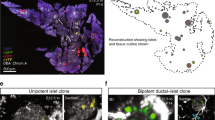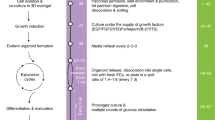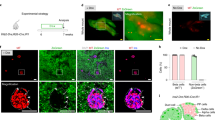Abstract
The clonal isolation of putative adult pancreatic precursors has been an elusive goal of researchers seeking to develop cell replacement strategies for diabetes. We report the clonal identification of multipotent precursor cells from the adult mouse pancreas. The application of a serum-free, colony-forming assay to pancreatic cells enabled the identification of precursors from pancreatic islet and ductal populations. These cells proliferate in vitro to form clonal colonies that coexpress neural and pancreatic precursor markers. Upon differentiation, individual clonal colonies produce distinct populations of neurons and glial cells, pancreatic endocrine β-, α- and δ-cells, and pancreatic exocrine and stellate cells. Moreover, the newly generated β-like cells demonstrate glucose-dependent Ca2+ responsiveness and insulin release. Pancreas colonies do not express markers of embryonic stem cells, nor genes suggestive of mesodermal or neural crest origins. These cells represent a previously unidentified adult intrinsic pancreatic precursor population and are a promising candidate for cell-based therapeutic strategies.
This is a preview of subscription content, access via your institution
Access options
Subscribe to this journal
Receive 12 print issues and online access
$209.00 per year
only $17.42 per issue
Buy this article
- Purchase on Springer Link
- Instant access to full article PDF
Prices may be subject to local taxes which are calculated during checkout






Similar content being viewed by others
References
Lechner, A. & Habener, J.F. Stem/progenitor cells from adult tissues: potential for the treatment of diabetes mellitus. Am. J. Physiol. Endocrinol. Metab. 284, E259–E266 (2003).
Ramiya, V.K. et al. Reversal of insulin-dependent diabetes using islets generated in vitro from pancreatic stem cells. Nat. Med. 6, 278–282 (2000).
Hunziker, E. & Stein, M. Nestin-expressing cells in the pancreatic islets of Langerhans. Biochem. Biophys. Res. Commun. 271, 116–119 (2000).
Zulewski, H. et al. Multipotential nestin-positive stem cells isolated from adult pancreatic islets differentiate ex vivo into pancreatic endocrine, exocrine, and hepatic phenotypes. Diabetes 50, 521–533 (2001).
Abraham, E.J., Leech, C.A., Lin, J.C., Zulewski, H. & Habener, J.F. Insulinotropic hormone glucagon-like peptide-1 differentiation of human pancreatic islet-derived progenitor cells into insulin-producing cells. Endocrinology 143, 3152–3161 (2002).
Lendahl, U., Zimmerman, L.B. & McKay, R.D. CNS stem cells express a new class of intermediate filament protein. Cell 60, 585–595 (1990).
Weiss, S. et al. Is there a neural stem cell in the mammalian forebrain? Trends Neurosci. 19, 387–393 (1996).
Seaberg, R.M. & van der Kooy, D. Adult rodent neurogenic regions: the ventricular subependyma contains neural stem cells, but the dentate gyrus contains restricted progenitors. J. Neurosci. 22, 1784–1793 (2002).
Hadjantonakis, A.-K., Gertsenstein, M., Ikawa, M., Okabe, M. & Nagy, A. Generating green fluorescent mice by germline transmission of green fluorescent ES cells. Mech. Dev. 76, 79–90 (1998).
Morshead, C.M., Garcia, A.D., Sofroniew, M.V. & van der Kooy, D. The ablation of glial fibrillary acidic protein-positive cells from the adult central nervous system results in the loss of forebrain neural stem cells but not retinal stem cells. Eur. J. Neurosci. 18, 76–84 (2003).
Tropepe, V. et al. Retinal stem cells in the adult mammalian eye. Science 287, 2032–2036 (2000).
Li, H., Liu, H. & Heller, S. Pluripotent stem cells from the adult mouse inner ear. Nat. Med. 9, 1293–1299 (2003).
Jonsson, J., Carlsson, L., Edlund, T. & Edlund, H. Insulin-promoter-factor 1 is required for pancreas development in mice. Nature 371, 606–609 (1994).
Guz, Y. et al. Expression of murine STF-1, a putative insulin gene transcription factor, in beta cells of pancreas, duodenal epithelium and pancreatic exocrine and endocrine progenitors during ontogeny. Development 121, 11–18 (1995).
Kritzik, M.R. et al. PDX-1 and Msx-2 expression in the regenerating and developing pancreas. J. Endocrinol. 163, 523–530 (1999).
Zhang, Y.-Q. & Sarvetnick, N. Development of cell markers for the identification and expansion of islet progenitor cells. Diabetes Metab. Res. Rev. 19, 363–374 (2003).
Sommer, L., Ma, Q. & Anderson, D.J. Neurogenins, a novel family of atonal-related bHLH transcription factors, are putative mammalian neuronal determination genes that reveal progenitor cell heterogeneity in the developing CNS and PNS. Mol. Cell. Neurosci. 8, 221–241 (1996).
Bylund, M., Andersson, E., Novitch, B.G. & Muhr, J. Vertebrate neurogenesis is counteracted by Sox1–3 activity. Nat. Neurosci. 6, 1162–1168 (2003).
Guillemot, F. & Joyner, A.L. Dynamic expression of the murine achaete-scute homologue Mash-1 in the developing nervous system. Mech. Dev. 42, 171–185 (1993).
Liu, Y. & Rao, M. Oligodendrocytes, GRPs and MNOPs. Trends Neurosci. 26, 410–412 (2003).
Rajagopal, J., Anderson, W.J., Kume, S., Martinez, O.I. & Melton, D.A. Insulin staining of ES cell progeny from insulin uptake. Science 299, 363 (2003).
Kang, G. et al. Epac-selective camp analog 8-pCPT-2′-O-Me-cAMP as a stimulus for Ca2+-induced Ca2+ release and exoctyosis in pancreatic β-cells. J. Biol. Chem. 278, 8279–8285 (2003).
MacDonald, P.E. et al. The multiple actions of GLP-1 on the process of glucose-stimulated insulin secretion. Diabetes 51, S434–S442 (2002).
Roe, M.W. et al. Expression and function of pancreatic beta-cell delayed rectifier K+ channels. Role in stimulus-secretion coupling. J. Biol. Chem. 271, 32241–32246 (1996).
Ahren, B., Karlsson, S. & Lindskog, S. Cholinergic regulation of the endocrine pancreas. Prog. Brain Res. 84, 209–218 (1990).
Lardon, J., Rooman, I. & Bouwens, L. Nestin expression in pancreatic stellate cells and angiogenic endothelial cells. Histochem. Cell Biol. 117, 535–540 (2002).
Seaberg, R.M. & van der Kooy, D. Stem and progenitor cells: the premature desertion of rigorous definitions. Trends Neurosci. 26, 125–131 (2003).
Mignone, J., Kukekov, V., Chiang, A.S., Steindler, D. & Enikolopov, G. Neural stem and progenitor cells in nestin-GFP transgenic mice. J. Comp. Neurol. 469, 311–324 (2004).
Sawamoto, K. et al. Generation of dopaminergic neurons in the adult brain from mesencephalic precursor cells labeled with a nestin-GFP transgene. J. Neurosci. 21, 3895–3903 (2001).
Weissman, I.L. Stem cells: Units of development, units of regeneration, and units in evolution. Cell 100, 157–168 (2000).
Nichols, J. et al. Formation of pluripotent stem cells in the mammalian embryo depends on the POU transcription factor Oct4. Cell 95, 379–391 (1998).
Chambers, I. et al. Functional expression cloning of Nanog, a pluripotency sustaining factor in embryonic stem cells. Cell 113, 643–655 (2003).
Gussoni, E. et al. Dystrophin expression in the mdx mouse restored by stem cell transplantation. Nature 401, 390–394 (1999).
Spangrude, G.J., Heimfeld, S. & Weissman, I.L. Purification and characterization of mouse hematopoietic stem cells. Science 241, 58–62 (1988).
Eftimie, R., Brenner, H. & Buonanno, A. Myogenin and MyoD join a family of skeletal muscle genes regulated by electrical activity. Proc. Natl. Acad. Sci. USA 88, 1349–1353 (1991).
Toma, J.G. et al. Isolation of multipotent adult stem cells from the dermis of mammalian skin. Nat. Cell Biol. 3, 778–784 (2001).
McKenzie, I. et al. Evidence that skin-derived precursor cells (skps) are an endogenous neural crest-derived precursor. Abstr. Soc. Neurosci. 28, 9 (2003).
Goulding, M.D., Chalepakis, G., Deutsch, U., Erselius, J.R. & Gruss, P. Pax-3, a novel murine DNA binding protein expressed during early neurogenesis. EMBO J. 10, 1135–1147 (1991).
Stoetzel, C., Weber, B., Bourgeois, P., Bolcato Bellemin, A.L. & Perrin Schmitt, F. Dorso-ventral and rostro-caudal sequential expression of M-twist in the postimplantation murine embryo. Mech. Dev. 51, 251–263 (1995).
Honore, S.M., Aybar, M.J. & Mayor, R. Sox10 is required for the early development of the prospective neural crest in Xenopus embryos. Dev. Biol. 260, 79–96 (2003).
Lee, H.Y. et al. Instructive role of Wnt/beta-catenin in sensory fate specification in neural crest stem cells. Science 303, 1020–1023 (2004).
Aybar, M.J., Nieto, M.A. & Mayor, R. Snail precedes slug in the genetic cascade required for the specification and migration of the Xenopus neural crest. Development 130, 483–494 (2003).
Morrison, S.J., White, P.M., Zock, C. & Anderson, D.J. Prospective identification, isolation by flow cytometry, and in vivo self-renewal of multipotent mammalian neural crest stem cells. Cell 96, 737–749 (1999).
Peterson, D.A., Leppert, J.T., Lee, K.-F. & Gage, F.H. Basal forebrain neuronal loss in mice lacking neurotrophin receptor p75. Science 277, 837–838 (1997).
Scharfmann, R. Neurotrophin and neurotrophin receptors in islet cells. Horm. Metab. Res. 29, 294–296 (1997).
Welsh, M. et al. The FRK/RAK tyrosine kinase participates in cytokine-induced islet cell toxicity. Biochem J. published online; doi: 10.1042/BJ20040285 (2004).
Garcia-Ocana, A. et al. Transgenic overexpression of hepatocyte growth factor in the beta-cell markedly improves islet function and islet transplant outcomes in mice. Diabetes 50, 2752–2762 (2001).
Lumelsky, N. et al. Differentiation of embryonic stem cells to insulin-secreting structures similar to pancreatic islets. Science 292, 1389–1394 (2001).
Sipione, S., Eshpeter, A., Lyon, J.G., Korbutt, G.S. & Bleackley, R.C. Insulin expressing cells from differentiated embryonic stem cells are not beta cells. Diabetologia 47, 499–508 (2004).
Persson-Sjogren, S., Zashihin, A. & Forsgren, S. Nerve cells associated with the endocrine pancreas in young mice: An ultrastructural analysis of the neuroinsular complex type I. Histochem. J. 33, 373–378 (2001).
Benveniste, P., Cantin, C., Hyam, D. & Iscove, N.N. Hematopoietic stem cells engraft in mice with absolute efficiency. Nat. Immunol. 4, 708–713 (2003).
Antonchuk, J., Sauvageau, G. & Humphries, R.K. HOXB4-induced expansion of adult hematopoietic stem cells ex vivo. Cell 109, 39–45 (2002).
Jiang, Y. et al. Pluripotency of mesenchymal stem cells derived from adult marrow. Nature 418, 41–49 (2002).
Clarke, D.L. et al. Generalized potential of adult neural stem cells. Science 288, 1660–1663 (2000).
Dor, Y., Brown, J., Martinez, O.I. & Melton, D. Adult pancreatic β-cells are formed by self-duplication rather than stem-cell differentiation. Nature 429, 41–46 (2004).
Morshead, C.M., Benveniste, P., Iscove, N.N. & van der Kooy, D. Hematopoietic competence is a rare property of neural stem cells that may depend on genetic and epigenetic alterations. Nat. Med. 8, 268–273 (2002).
Piper, K. et al. Beta-cell differentiation during human development does not rely on nestin-positive precursors: implications for stem cell-derived replacement therapy. Diabetologia 45, 1045–1047 (2002).
Humphrey, R.K. et al. Characterization and isolation of promoter-defined nestin-positive cells from the human fetal pancreas. Diabetes 52, 2519–2525 (2003).
Treutelaar, M.K. et al. Nestin-lineage cells contribute to the microvasculature but not endocrine cells of the islet. Diabetes 52, 2503–2512 (2003).
Delacour, A., Nepote, V., Trumpp, A. & Herrera, P.L. Nestin expression in pancreatic exocrine cell lineages. Mech. Dev. 121, 3–14 (2004).
Esni, F., Stoffers, D.A., Takeuchi, T. & Leach, S.D. Origin of exocrine pancreatic cells from nestin-positive precursors in the developing mouse pancreas. Mech. Dev. 121, 15–25 (2004).
Street, C.N. et al. Heterogenous expression of nestin in human pancreatic tissue precludes its use as an islet precursor marker. J. Endocrinol. 180, 213–225 (2004).
Klein, T. et al. Nestin is expressed in vascular endothelial cells in the adult human pancreas. J. Histochem. Cytochem. 51, 697–706 (2003).
Selander, L. & Edlund, H. Nestin is expressed in mesenchymal and not epithelial cells of the developing mouse pancreas. Mech. Dev. 113, 189–192 (2002).
Polesskaya, A., Seale, P. & Rudnicki, M.A. Wnt signaling induces the myogenic specification of resident CD45+ adult stem cells during muscle regeneration. Cell 113, 841–852 (2003).
Gotoh, M., Maki, J., Kiyoizumi, T., Satomi, S. & Monaco, A.P. An improved method for isolation of mouse pancreatic islets. Transplantation 40, 437–438 (1985).
Tropepe, V. et al. Distinct neural stem cells proliferate in response to EGF and FGF2 in the developing mouse telencephalon. Dev. Biol. 208, 166–188 (1999).
Smukler, S.R., Tang, L., Wheeler, M.B. & Salapatek, A.M.F. Exogenous nitric oxide and endogenous glucose-stimulated β-cell nitric oxide augment insulin release. Diabetes 51, 3450–3460 (2002).
Acknowledgements
We thank D. Dixon for excellent tissue isolation and purification, C. Smith for expert assistance with FACS analysis, A. Nagy for the gift of Oct4-GFP transgenic mice, M. Yamaguchi for the gift of nestin-GFP transgenic mice, M. Grompe for the gift of anti-FAH chicken polyclonal antibody and R.D.G. McKay for the gift of anti-nestin rabbit polyclonal antibody. This study was supported by the Canadian Stem Cell Network and the Canadian Institutes of Health Research.
Author information
Authors and Affiliations
Corresponding author
Ethics declarations
Competing interests
The authors declare no competing financial interests.
Supplementary information
Supplementary Fig. 1
Differentiated PMP colonies contain β-cells that co-express Pax6 (red) and C-peptide (green). (PDF 253 kb)
Supplementary Fig. 2
PMPs are present in both nestin+ and nestin− cell fractions from both islet and ductal cell isolates, but all PMP colonies are nestin+ after 7 days in vitro. (PDF 209 kb)
Supplementary Table 1
Comparison of the gene expression profile of PMP colonies and brain-derived neurospheres by RT-PCR analysis, for both undifferentiated and differentiated conditions. (PDF 6 kb)
Rights and permissions
About this article
Cite this article
Seaberg, R., Smukler, S., Kieffer, T. et al. Clonal identification of multipotent precursors from adult mouse pancreas that generate neural and pancreatic lineages. Nat Biotechnol 22, 1115–1124 (2004). https://doi.org/10.1038/nbt1004
Received:
Accepted:
Published:
Issue Date:
DOI: https://doi.org/10.1038/nbt1004
This article is cited by
-
Isolation of mouse pancreatic islet Procr+ progenitors and long-term expansion of islet organoids in vitro
Nature Protocols (2022)
-
Glucocorticoid agonists enhance retinal stem cell self-renewal and proliferation
Stem Cell Research & Therapy (2021)
-
Establishment of functional epithelial organoids from human lacrimal glands
Stem Cell Research & Therapy (2021)
-
Ontology of the apelinergic system in mouse pancreas during pregnancy and relationship with β-cell mass
Scientific Reports (2021)
-
Organoids from the Human Fetal and Adult Pancreas
Current Diabetes Reports (2019)



